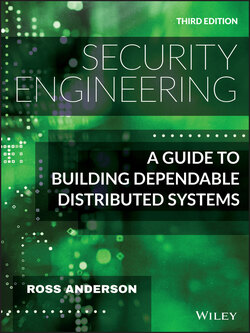Читать книгу Security Engineering - Ross Anderson - Страница 147
5.2.2 The one-time pad
ОглавлениеOne way to make a stream cipher of this type proof against attacks is for the key sequence to be as long as the plaintext, and to never repeat. This is known as the one-time pad and was proposed by Gilbert Vernam during World War I [1003]; given any ciphertext, and any plaintext of the same length, there's a key that decrypts the ciphertext to the plaintext. So regardless of the amount of computation opponents can do, they're none the wiser, as given any ciphertext, all possible plaintexts of that length are equally likely. This system therefore has perfect secrecy.
Here's an example. Suppose you had intercepted a message from a wartime German agent which you knew started with ‘Heil Hitler’, and the first ten letters of ciphertext were DGTYI BWPJA. So the first ten letters of the one-time pad were wclnb tdefj, as shown in Figure 5.3:
| Plain | heilhitler |
| Key | wclnbtdefj |
| Cipher | DGTYIBWPJA |
Figure 5.3: A spy's message
But once he's burnt the piece of silk with his key material, the spy can claim that he's actually a member of the underground resistance, and the message actually said ‘Hang Hitler’. This is also possible, as the key material could just as easily have been wggsb tdefj, as shown in Figure 5.4:
| Cipher | DGTYIBWPJA |
| Key | wggsbtdefj |
| Plain | hanghitler |
Figure 5.4: What the spy can claim he said
Now we rarely get anything for nothing in cryptology, and the price of the perfect secrecy of the one-time pad is that it fails completely to protect message integrity. So if you wanted to get this spy into trouble, you could change the ciphertext to DCYTI BWPJA (Figure 5.5):
| Cipher | DCYTIBWPJA |
| Key | wclnbtdefj |
| Plain | hanghitler |
Figure 5.5: Manipulating the message to entrap the spy
Leo Marks’ engaging book on cryptography in the Special Operations Executive in World War II [1226] relates how one-time key material was printed on silk, which agents could conceal inside their clothing; whenever a key had been used it was torn off and burnt. In fact, during the war, Claude Shannon proved that a cipher has perfect secrecy if and only if there are as many possible keys as possible plaintexts, and every key is equally likely; so the one-time pad is the only kind of system that offers perfect secrecy. He was finally allowed to publish this in 1948 [1717, 1718].
The one-time tape was used for top-level communications by both sides from late in World War II, then for strategic communications between NATO allies, and for the US-USSR hotline from 1963. Thousands of machines were produced in total, using paper tapes for key material, until they were eventually replaced by computers from the mid-1980s1. But such cryptography is too expensive for most applications as it consumes as much key material as there is traffic. It's more common for stream ciphers to use a pseudorandom number generator to expand a short key into a long keystream. The data is then encrypted by combining the keystream, one symbol at a time, with the data. It's not enough for the keystream to appear “random” in the sense of passing the standard statistical randomness tests: it must also have the property that an opponent who gets his hands on even quite a lot of keystream symbols should not be able to predict any more of them.
An early example was rotor machines, mechanical stream-cipher devices that produce a very long sequence of pseudorandom states2 and combine them with plaintext to get ciphertext. These machines were independently invented by a number of people from the 1920s, many of whom tried to sell them to the banking industry. Banks weren't in general interested, for reasons we'll discuss below, but rotor machines were very widely used by the combatants in World War II to encipher radio traffic, and the efforts made by the Allies to decipher German traffic included the work by Alan Turing and others on Colossus, which helped kickstart the computer industry after the war.
Stream ciphers have been widely used in hardware applications where the number of gates had to be minimised to save power. However, block ciphers are more flexible and are more common in systems being designed now, so let's look at them next.
